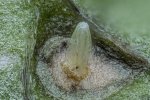
News
Cabbage whites triggered egg-killing leaf necrosis in crucifers
Until now, little was known about how plants protect themselves from plant-eating insects and how the arms race between insects and plants unfolded. Researchers from Wageningen University & Research have gained more insight into this: strong leaf necrosis - the mechanism by which plants detect and kill the eggs of butterflies and other insects on their leaves - emerged almost exclusively in cruciferous plants and their wild relatives that were attacked by cabbage whites who had developed immunity to the plants’ toxic mustard oil. A publication on this subject appeared in the journal New Phytologist.
The cabbage white butterfly owes its name to its preference for Brussels sprouts, rapeseed and other cultivated crucifers as host plants. However, when a cabbage white (Pieridae) lays its eggs on wild crucifer plants such as black mustard (Brassica nigra), the plant can initiate a necrotic reaction which causes the leaf beneath the egg to die in a controlled manner. This causes the egg to desiccate and fall off the plant.
To understand the evolutionary origin and distribution of this plant defence trait, a research team led by the Biosystematics Group screened 31 plant species within the crucifer family for the necrotic response to a wash made from eggs of nine butterfly species.
“The experiments showed that the strong leaf necrosis evolved almost exclusively in the lineage of the cabbage crops and their wild relatives naturally attacked by cabbage white butterflies”, says research leader Nina Fatouros. “Moreover, leaf necrosis was triggered only by those butterfly species within the Pieridae family that are specialists of crucifers and are able to feed on them despite the crucifers’ toxic mustard oils.”
An undamaged cabbage white butterfly egg triggering a leaf necrosis in wild crucifer plants (left) leading to egg desiccation (right). Such egg-killing defence traits are often observed in nature and can lead to egg mortalities up to 80%. Photo: Hans M. Smid, Laboratory of Entomology, WUR.
These findings suggest that the egg-killing trait has evolved in the crucifer family as a counteradaptation to the ability of caterpillars to detoxify mustard oils. Being part of an ongoing arms-race, some butterflies likely adapted to egg-killing by clustering eggs in groups (thus less affected by necrosis), by switching to other host plants, or by depositing eggs on flowers instead of leaves.
The team is currently investigating the genetic basis of the egg-killing plant trait in a big research project financed by the Dutch Research Council (NWO) to ultimately develop crops that are resistant to pest insects.

